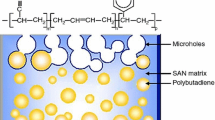Abstract
The relation between surface preconditioning and metal deposition in the direct galvanic metallization of different insulating polymer surfaces by the so-called PLATO technique was studied using electrochemical and surface analytical methods. AFM, XPS and contact angle measurements show that the chromic acid etching of original polymer surfaces leads to an increase of the surface energy and hydrophilicity of polymer substrates due to both surface roughening and the formation of -COOH and/or -COH surface groups. However, decisive for the subsequent surface activation with cobalt sulfide is the increase in surface roughness. The influence of the degree of activation and the electrode potential on the kinetics of Ni metallization was studied by current transient measurements on activated line-shaped structures. The results suggest that the electrochemical reduction of cobalt sulfide to cobalt is a necessary step to induce the process of Ni electrodeposition. Successful Ni metallization could be obtained on ABS (acrylonitrile-butadiene-styrene) and PEEK (poly-ether-ether-ketone) surfaces. The lateral propagation rate, V x , of the depositing Ni layer depends exponentially on the applied potential and was found to be several orders of magnitude higher than the Ni deposition rate, V z , in the normal z-direction (V x /V z =102–104). It was demonstrated that the approach involving cobalt sulfide pre-activation can also be applied successfully for metallization of oxidized porous silicon surfaces.










Similar content being viewed by others
References
Sacher E, Piraeux JJ, Kovalczyck SP (1990) Metallization of polymers. American Chemical Society, Washington
Hupe J, Kronenberg W (Blasberg Oberflächentechnik) (1989) Pat Appl, PCT/EP89/00204
Schattka D, Winkels S, Schultze JW (1997) Metalloberfläche 5:1823
Pilyte S, Valiuliene G, Zieliene A, Vinkevicius J (1997) J Electroanal Chem 436:127
Vinkevicius J, Mozginskie I, Jasulaitiene V (1998) J Electroanal Chem 442:73
Vaskelis A, Norkus B, Rozovskis G, Vinkevicius J (1997) Trans IMF 75:1
Möbius A, Pies P, Könighofen A (2000) Metalloberfläche 54:3
Möbius A (2000) J Oberflächetechnik 14
Möbius A, et al. (Enthone OMI) (2000) Pat Appl, PCT/US99/26066
Chan H (1992) Polymer surface modification and characterization. Hanser, Munich
Brocherieux A, Dessaux O, Goumand P, Gengembre L, Grimblot J, Brunel M, Razzaroni R (1995) Appl Surf Sci 90:47
Ha SW, Hauert R, Ernst KH, Wintermantel E (1997) Surf Coat Technol 96:293
Veeramasuneni S, Drelich J, Miller JD, Yamauchi G (1997) Prog Org Coat 31:265
Packham DE (1996) Int J Adhesion Adhesives 16:121
Duca M, Plosceanu C, Pop T (1998) Polymer Degrad Stab 61:65
Zhang XG (2001) Electrochemistry of silicon and its oxide. Kluwer, New York
Lehmann V (2002) Electrochemistry of silicon: instrumentation, science, materials and applications. Wiley-VCH, Weinheim
Acknowledgements
The authors express their gratitude to A. Möbius and A. Fuhrmann (Enthone, Langenfeld, Germany) for technical support and helpful discussions on some points of this study. Financial support of this work by the Ministerium für Schule, Weiterbildung, Wissenschaft und Forschung des Landes Nordrhein-Westfalen (MSWWF-NRW) is also gratefully acknowledged.
Author information
Authors and Affiliations
Corresponding author
Additional information
Presented at the 3rd International Symposium on Electrochemical Processing of Tailored Materials held at the 53rd Annual Meeting of the International Society of Electrochemistry, 15–20 September 2002, Düsseldorf, Germany
Rights and permissions
About this article
Cite this article
Mai, T.T., Schultze, J.W. & Staikov, G. Relation between surface preconditioning and metal deposition in direct galvanic metallization of insulating surfaces. J Solid State Electrochem 8, 201–208 (2004). https://doi.org/10.1007/s10008-003-0426-4
Received:
Accepted:
Published:
Issue Date:
DOI: https://doi.org/10.1007/s10008-003-0426-4




